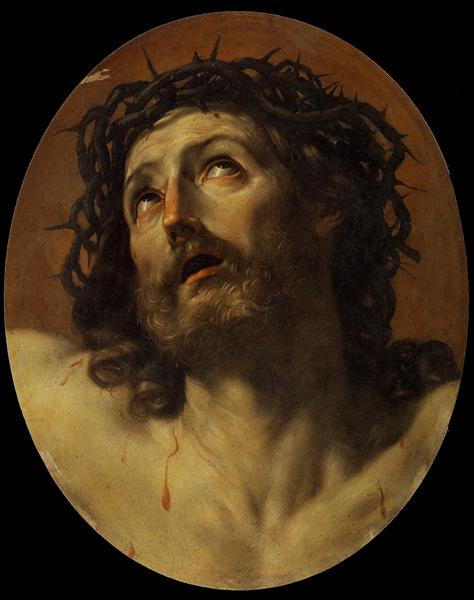Baroque-Head of Christ Crowned With Thorns
Background
This piece is called Head of Christ Crowned With Thorns, painted in 1620 by Guido Reni. I could not find a specific location for this piece, however, the artist is Italian, so it is safe to believe that was this was where the painting was created. More specifically, it was likely painted in Rome If it was not created in Italy, his biography also mentions that he created a lot of work in Naples, where he took a lot of commissions. Beyond that, it appears as if not a lot is known about this painting.
Influence
This painting is an excellent example of the influence of The Council of Trent on Baroque era art. The Council took place between 1545 and 1563, and determined that art should glorify God, and be easily understandable by both the secular and religious world.
This piece paints a moment of immense trauma (the days leading up to the crucifixion) as almost beautiful in a way. It has a harsh delicacy that leads a viewer to linger. Additionally, it conveys the weight and unpleasantness of the situation to the viewer, which would come across whether you were a layperson without religious knowledge, or a devout practitioner.
In whole, this piece is a perfect example of what the council was trying to encourage within artwork. Although I couldn't find a background that confirmed what influenced this piece, my best guess is it was influenced by the tenants of the council. Although it came 60 years after the initial meetings, it does appear to embody the meeting's mission, so that is my best guess for some of the ideology that inspired Reni to paint this religious iconography.
My Opinion
This piece in particular embodies the important characteristics of Baroque era art. Firstly, there is an immense sense of tension. From my religious knowledge, this is a representation of when Jesus is given a crown of thorns and mocked in the days leading to his crucifixion. You can see in the eyes of the painting that Jesus is pained, and blood drips down his chest, adding a sense of motion that is also integral to baroque pieces. Finally, this piece is very dark and dramatic, which was a hallmark of this artistic era.
The aspects I discussed above are the reason that I enjoy this painting. Usually, I am more specific, but the overall baroque style was something I immensely appreciated. I find the almost color stripped pallet, accentuated with blood-red to be extremely attractive. The harsh shadows lend a sense of intense drama, which gives me a sense of emotional investment in the painting itself. Overall, this is a lovely work. It is not one I'd own, as I find it inappropriate to own artwork glorifying religions that I do not belong to, but I would love to see it in person.
Citations
“Guido Reni.” Artnet, www.artnet.com/artists/guido-reni/.
“How to Recognize Baroque Art.” Youtube, Smart History, www.youtube.com/watch?v=EFHPAbHaoqk&feature=youtu.be.
Kljaich, Lisa. “Religion Transcript (PDF).” Art 200, art200.community.uaf.edu/wp-content/uploads/sites/654/audio_transcripts/CounterReformation.mp3.pdf.

I am personally not a fan of religious artwork, because to me it conveys a certain type of control that the church had over government and artists in general—and leads me to wonder what kind of beauty these artists could have painted if they hadn't done work like this on commission or order from a higher authority. I do, however, agree that it is quite evocative as a piece of artwork. It translates the idea of great suffering and as far as relation to the theme, it very directly illustrates the suffering of Christ, a main theme of religious (re: Christian) artwork during the time. I definitely appreciate your choice in art, for illustrating the theme of most of the Baroque era of artwork, as well as the skill that it would have taken to paint it in the first place.
ReplyDelete